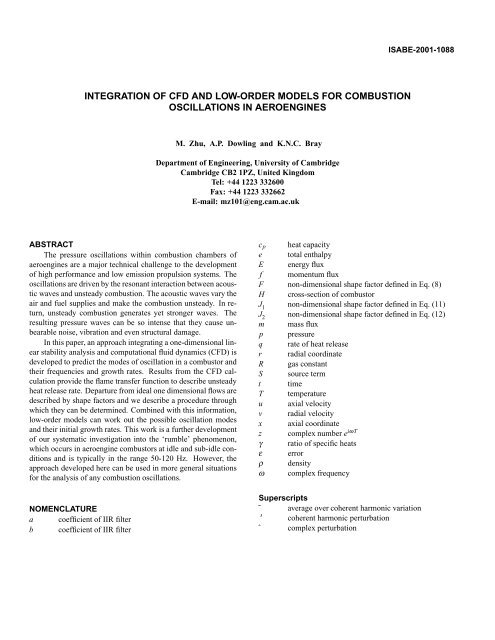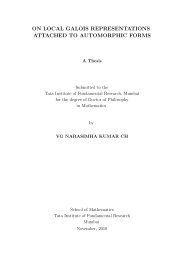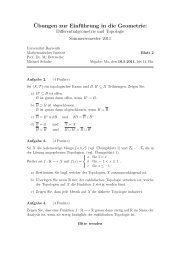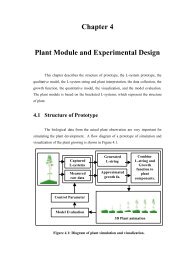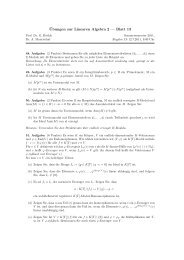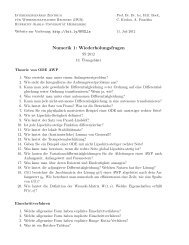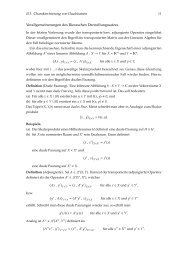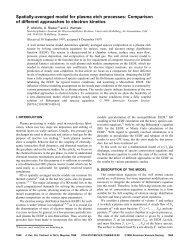integration of cfd and low-order models for combustion ... - IWR
integration of cfd and low-order models for combustion ... - IWR
integration of cfd and low-order models for combustion ... - IWR
You also want an ePaper? Increase the reach of your titles
YUMPU automatically turns print PDFs into web optimized ePapers that Google loves.
ISABE-2001-1088<br />
INTEGRATION OF CFD AND LOW-ORDER MODELS FOR COMBUSTION<br />
OSCILLATIONS IN AEROENGINES<br />
M. Zhu, A.P. Dowling <strong>and</strong> K.N.C. Bray<br />
Department <strong>of</strong> Engineering, University <strong>of</strong> Cambridge<br />
Cambridge CB2 1PZ, United Kingdom<br />
Tel: +44 1223 332600<br />
Fax: +44 1223 332662<br />
E-mail: mz101@eng.cam.ac.uk<br />
ABSTRACT<br />
The pressure oscillations within <strong>combustion</strong> chambers <strong>of</strong><br />
aeroengines are a major technical challenge to the development<br />
<strong>of</strong> high per<strong>for</strong>mance <strong>and</strong> <strong>low</strong> emission propulsion systems. The<br />
oscillations are driven by the resonant interaction between acoustic<br />
waves <strong>and</strong> unsteady <strong>combustion</strong>. The acoustic waves vary the<br />
air <strong>and</strong> fuel supplies <strong>and</strong> make the <strong>combustion</strong> unsteady. In return,<br />
unsteady <strong>combustion</strong> generates yet stronger waves. The<br />
resulting pressure waves can be so intense that they cause unbearable<br />
noise, vibration <strong>and</strong> even structural damage.<br />
In this paper, an approach integrating a one-dimensional linear<br />
stability analysis <strong>and</strong> computational fluid dynamics (CFD) is<br />
developed to predict the modes <strong>of</strong> oscillation in a combustor <strong>and</strong><br />
their frequencies <strong>and</strong> growth rates. Results from the CFD calculation<br />
provide the flame transfer function to describe unsteady<br />
heat release rate. Departure from ideal one dimensional f<strong>low</strong>s are<br />
described by shape factors <strong>and</strong> we describe a procedure through<br />
which they can be determined. Combined with this in<strong>for</strong>mation,<br />
<strong>low</strong>-<strong>order</strong> <strong>models</strong> can work out the possible oscillation modes<br />
<strong>and</strong> their initial growth rates. This work is a further development<br />
<strong>of</strong> our systematic investigation into the ‘rumble’ phenomenon,<br />
which occurs in aeroengine combustors at idle <strong>and</strong> sub-idle conditions<br />
<strong>and</strong> is typically in the range 50-120 Hz. However, the<br />
approach developed here can be used in more general situations<br />
<strong>for</strong> the analysis <strong>of</strong> any <strong>combustion</strong> oscillations.<br />
NOMENCLATURE<br />
a coefficient <strong>of</strong> IIR filter<br />
b coefficient <strong>of</strong> IIR filter<br />
c p heat capacity<br />
e total enthalpy<br />
E energy flux<br />
f momentum flux<br />
F non-dimensional shape factor defined in Eq. (8)<br />
H cross-section <strong>of</strong> combustor<br />
J 1<br />
non-dimensional shape factor defined in Eq. (11)<br />
J 2<br />
non-dimensional shape factor defined in Eq. (12)<br />
m mass flux<br />
p pressure<br />
q rate <strong>of</strong> heat release<br />
r radial coordinate<br />
R gas constant<br />
S source term<br />
t time<br />
T temperature<br />
u axial velocity<br />
v radial velocity<br />
x axial coordinate<br />
z complex number e iωT<br />
γ ratio <strong>of</strong> specific heats<br />
ε error<br />
ρ density<br />
ω complex frequency<br />
Superscripts<br />
¯ average over coherent harmonic variation<br />
coherent harmonic perturbation<br />
ˆ complex perturbation
1 INTRODUCTION<br />
The pressure oscillations that can occur within the <strong>combustion</strong><br />
chambers <strong>of</strong> aeroengines are a major technical challenge to<br />
the development <strong>of</strong> high per<strong>for</strong>mance <strong>and</strong> <strong>low</strong> emission propulsion<br />
systems. The oscillations are driven by the resonant interaction<br />
between acoustic waves <strong>and</strong> unsteady <strong>combustion</strong>. The<br />
acoustic waves vary the air <strong>and</strong> fuel supplies <strong>and</strong> make the <strong>combustion</strong><br />
unsteady. In return, unsteady <strong>combustion</strong> generates yet<br />
stronger waves. The pressure waves can become so intense that<br />
they cause unbearable noise, vibration <strong>and</strong> even structural damage.<br />
It is known that the <strong>combustion</strong> oscillation is a systemcoupled<br />
phenomenon, which involves the interaction <strong>of</strong> pressure<br />
waves, unsteady <strong>combustion</strong>, fuel/air supplies, <strong>and</strong> geometry <strong>of</strong><br />
combustors. In <strong>order</strong> to fully investigate the phenomenon, a combination<br />
<strong>of</strong> theoretical analysis, computational fluid dynamics<br />
<strong>and</strong> experimental work is needed. These techniques combine together<br />
to provide comprehensive in<strong>for</strong>mation to underst<strong>and</strong> <strong>combustion</strong><br />
oscillations <strong>and</strong> to develop control strategies.<br />
For aeroengines gas turbines, combustors with fuel spray atomizers<br />
are particularly susceptible to a <strong>low</strong> frequency oscillation<br />
at idle <strong>and</strong> sub-idle conditions. The frequency <strong>of</strong> this oscillation<br />
is typically in the range 50-120 Hz <strong>and</strong> is commonly<br />
called ‘rumble’. In recent years, a systematic program <strong>of</strong> work<br />
has been undertaken to investigate the ‘rumble’ phenomenon. In<br />
our study, CFD has been employed to calculate unsteady <strong>combustion</strong><br />
f<strong>low</strong>s at idle conditions. Through harmonic <strong>for</strong>cing <strong>of</strong><br />
the air or fuel supplies, the main source <strong>of</strong> the unsteady heat release<br />
has been identified [1]. Excitation by broad-b<strong>and</strong> signals<br />
gives fuller in<strong>for</strong>mation on the ‘flame transfer function’ between<br />
the rate <strong>of</strong> unsteady <strong>combustion</strong> <strong>and</strong> change in the air mass f<strong>low</strong><br />
rate [2]. In the primary zone, an increase in the inlet air mass f<strong>low</strong><br />
rate increases the turbulence scalar dissipation rate <strong>and</strong> hence the<br />
rate <strong>of</strong> <strong>combustion</strong>. The increase <strong>of</strong> air mass f<strong>low</strong> at the atomizer<br />
leads to a decrease in the inlet fuel droplet size. These smaller<br />
droplets evaporate quickly, increasing the gaseous mixture fraction<br />
in the recirculation zone with a recirculation time delay, <strong>and</strong><br />
this also influences the instantaneous rate <strong>of</strong> <strong>combustion</strong> <strong>and</strong> the<br />
location <strong>of</strong> the burning region. When the boundary conditions<br />
<strong>of</strong> the combustor are modified to describe the inlet air <strong>and</strong> fuel<br />
supplies <strong>and</strong> to include a downstream nozzle, the self-excited oscillations<br />
are established [3]. The causes <strong>of</strong> the oscillation have<br />
been identified: pressure variations in the combustor chamber alter<br />
the inlet air <strong>and</strong> fuel spray characteristics, <strong>and</strong> thereby change<br />
the rate <strong>of</strong> <strong>combustion</strong> <strong>and</strong> generate ‘hot spots’, which convect<br />
downstream. As these ‘hot spots’ accelerate through the downstream<br />
nozzle, an upstream propagating acoustic wave is generated,<br />
which at certain discrete frequencies rein<strong>for</strong>ces the pressure<br />
oscillation.<br />
Although CFD provides a powerful tool to underst<strong>and</strong> <strong>combustion</strong><br />
oscillations, there are two drawbacks to relying entirely<br />
on this method. One is that the calculations are very timeconsuming,<br />
<strong>and</strong> it is not feasible to investigate a wide range <strong>of</strong><br />
combustor geometries <strong>and</strong> f<strong>low</strong> conditions. The second is that<br />
the calculations are carried out in the time domain. An unstable<br />
operating condition is recognized by tracking the time evolution<br />
until a self-excited oscillation is established. Long simulation<br />
times are necessary to demonstrate stability. These time domain<br />
calculations provide detailed in<strong>for</strong>mation on the f<strong>low</strong> motion, but<br />
there is no direct in<strong>for</strong>mation on the damping factor. The latter<br />
is very useful in determining how close an operating point is to a<br />
instability boundary <strong>and</strong> in developing control strategies. These<br />
self-excited oscillations involve an almost one-dimensional interaction,<br />
consisting <strong>of</strong> the convection <strong>of</strong> ‘hot spots’ downstream<br />
<strong>and</strong> upstream propagation <strong>of</strong> a plane acoustic wave. We might<br />
there<strong>for</strong>e hope to describe it much more quickly through a onedimensional<br />
analysis. Moreover, the stability can be investigate<br />
the linearized equations <strong>of</strong> motion, where one is interested in<br />
whether disturbances with time dependence e iωt grow or decay<br />
with time.<br />
In this paper, a one-dimensional linear stability analysis <strong>and</strong><br />
CFD are integrated to study <strong>combustion</strong> oscillations. With this<br />
approach, CFD simulation <strong>and</strong> stability analysis work together to<br />
provide comprehensive in<strong>for</strong>mation on the mechanism <strong>of</strong> <strong>combustion</strong><br />
oscillation. Results from the CFD calculation provide<br />
the flame transfer function to describe unsteady heat release rate.<br />
Departure from ideal one dimensional f<strong>low</strong>s are described by<br />
shape factors <strong>and</strong> we describe a procedure through which they<br />
can be determined. Combined with this in<strong>for</strong>mation, <strong>low</strong>-<strong>order</strong><br />
<strong>models</strong> can work out the possible oscillation modes <strong>and</strong> their initial<br />
growth rates. This work is a further development <strong>of</strong> our systematic<br />
investigation into the ‘rumble’ phenomenon, which occurs<br />
in aeroengine combustors at idle <strong>and</strong> sub-idle conditions <strong>and</strong><br />
is typically in the range 50-120 Hz. However, the approach developed<br />
here can be used in more general situations <strong>for</strong> the analysis<br />
<strong>of</strong> any <strong>combustion</strong> oscillations. In the next section, the areaaveraged<br />
equations <strong>for</strong> a quasi-one-dimensional stability analysis<br />
are derived through integrating the equations <strong>of</strong> motion. Three<br />
non-dimensional shape factors are defined to account the effects<br />
<strong>of</strong> non-uni<strong>for</strong>mity in the radial direction. In section 3, based on<br />
the integrated equations, the equations <strong>for</strong> mean f<strong>low</strong> <strong>and</strong> linear<br />
perturbations are derived from these area-averaged equations.<br />
The determination <strong>of</strong> the flame transfer function <strong>and</strong> shape factors<br />
from a single <strong>for</strong>ced CFD calculation are briefly introduced.<br />
In section 4, we integrate the <strong>models</strong> from this CFD calculation<br />
with the linear perturbation equations. The results are compared<br />
with those from CFD calculation per<strong>for</strong>med with the same inlet<br />
boundary conditions. The sensitivities <strong>of</strong> the shape factor perturbations<br />
are also investigated. Finally, the conclusions are presented<br />
in section 5.<br />
2 INTEGRATED EQUATIONS<br />
As the ‘rumble’ problem we consider here is a <strong>low</strong> frequency<br />
oscillation <strong>and</strong> the wavelengths are long in comparison
©<br />
©<br />
©<br />
©<br />
©<br />
¢<br />
©<br />
¢<br />
©<br />
©<br />
©<br />
©<br />
¢<br />
©<br />
©<br />
¢<br />
¢<br />
©<br />
<br />
¡<br />
©<br />
©<br />
©<br />
©<br />
©<br />
©<br />
©<br />
©<br />
©<br />
©<br />
©<br />
©<br />
©<br />
with the combustor diameter, only plane acoustic waves carry<br />
energy. There<strong>for</strong>e, it is reasonable to consider one-dimensional<br />
disturbance in stability analysis. The f<strong>low</strong>s we consider are axisymmetric<br />
<strong>and</strong> the ensemble averaged equations can be written<br />
in two-dimensional <strong>for</strong>m. With the assumption <strong>of</strong> negligible<br />
molecular transport, <strong>and</strong> negligible Reynolds stresses <strong>and</strong> fluxes,<br />
the ensemble averaged conservation equations are<br />
In Eq. (6), the non-uni<strong>for</strong>m influences <strong>of</strong> momentum transport<br />
in the radial direction are considered through a shape factor<br />
F, which is defined as<br />
F ¢ x¦ t£¥¤<br />
u 2 <br />
2<br />
¤<br />
u<br />
ρ H <br />
r<br />
rρu 2 dr<br />
r<br />
r<br />
rρudr 2<br />
§ (8)<br />
r<br />
<br />
<br />
∂ ¢<br />
ρu£<br />
∂t<br />
∂ρ<br />
∂t<br />
∂ ¡<br />
ρu 2 £<br />
∂x<br />
∂ ¡<br />
∂x<br />
∂ ¢<br />
ρe<br />
∂t t £<br />
∂ ¡ ¢<br />
ρu£<br />
∂x<br />
¡ 1<br />
r<br />
ρue£<br />
∂<br />
∂r<br />
¡ 1<br />
r<br />
∂<br />
∂r<br />
rρv£¥¤ 0 ¦ (1)<br />
¡ rρuv£<br />
¡<br />
rρve£¥¤ §<br />
∂ p<br />
∂x 0 (2)<br />
1 ∂<br />
r ∂r<br />
q (3)<br />
Here <strong>and</strong> be<strong>low</strong>, we define p, q <strong>and</strong> ρ as Reynolds ensemble<br />
averages <strong>and</strong> u, v, T etc as Favre ensemble averages over turbulent<br />
f<strong>low</strong> fluctuations at x¦ r¦ t£ given . t is the time. x <strong>and</strong> r<br />
are the spatial coordinates in the axial <strong>and</strong> radial direction, respectively,<br />
<strong>and</strong> u <strong>and</strong> v are the corresponding gas phase ¢ velocity<br />
components; p is the pressure. e t is the internal <strong>and</strong> mechanical<br />
energy e t ¤<br />
1<br />
c v T<br />
2 u2 α , <strong>and</strong> e is the total enthalpy given by<br />
¡ ¡<br />
e ¤ e t ¤ ρ p¨<br />
1<br />
c p T<br />
2 u2 α. In this work, the direct effects <strong>of</strong><br />
the droplet evaporation <strong>and</strong> transportation are neglected from the<br />
mass <strong>and</strong> momentum equations, but they influence q, the ¡ instantaneous<br />
rate <strong>of</strong> heat release/volume.<br />
The one-dimensional equations can be obtained by the integrating<br />
the Eqs. (1)-(3) over the cross-section. With the assumption<br />
<strong>of</strong> frictionless slip f<strong>low</strong>s at walls without heat transfer, the<br />
quantities integrated f<strong>low</strong> equations across the width <strong>of</strong> a combustor<br />
can be written as<br />
φ ¤<br />
<br />
1<br />
H<br />
r<br />
r<br />
rφ dr ¦ <strong>and</strong> © ψ¤<br />
1<br />
ρ H<br />
r<br />
r<br />
rρψ dr ¦ (4)<br />
where φ represents ρ <strong>and</strong> q, <strong>and</strong> ψ represents u, v, u 2 , e t <strong>and</strong><br />
e. H © x£¤<br />
r<br />
r rdr, is the cross-sectional area <strong>of</strong> the combustor,<br />
<strong>and</strong> is uni<strong>for</strong>m in this study. Integrating Eqs. (1)-(3), onedimensional<br />
conservation equations can be written ¢ as<br />
∂ ¡ 1 ρ ∂<br />
H © © u¤ S ρ<br />
m (5)<br />
¦<br />
∂t H ∂x <br />
¡ ∂ 1 ∂ 2 d p ¡<br />
u ρ<br />
ρ u HF¤ S<br />
∂t H ∂x dx f<br />
(6) ¦<br />
<br />
<br />
¡ ∂<br />
1 ∂<br />
e ρ<br />
∂t t <br />
e ρ H¤ q S u<br />
e (7) §<br />
H <br />
∂x<br />
where S m , S f<br />
<strong>and</strong> S e are the sources terms <strong>of</strong> mass, momentum<br />
<strong>and</strong> energy due to the primary <strong>and</strong> secondary air injections, respectively.<br />
For the total energy <strong>and</strong> total enthalpy, the integrated variable can<br />
be written as<br />
©<br />
e t ¤ c v T<br />
e¥¤ c p<br />
©<br />
1 2 © ¡<br />
F <strong>and</strong> ¦ (9)<br />
u<br />
2<br />
T J 1<br />
¡ 1<br />
2<br />
u 2 J 2<br />
§ (10)<br />
The dimensionless shape factors J 1<br />
<strong>and</strong> J 2<br />
are used to describe<br />
the non-uni<strong>for</strong>m influences <strong>of</strong> the enthalpy <strong>and</strong> kinetic energy<br />
transports in the radial direction, <strong>and</strong> are defined as<br />
¢<br />
J 1<br />
t£¥¤ x¦<br />
¢<br />
J 2<br />
t£¥¤ x¦<br />
c p uT<br />
¦ (11)<br />
<strong>and</strong>¦<br />
c p T u <br />
u 3 ¨<br />
u 3 ¦ (12)<br />
respectively. Although the heat capacity c p <strong>and</strong> state equation coefficient<br />
R are not uni<strong>for</strong>m within <strong>combustion</strong> chamber as <strong>combustion</strong><br />
alters the components <strong>of</strong> f<strong>low</strong>, we find from our later results<br />
that it is accurate enough to treat them as constants.<br />
The shape factors (F, J 1<br />
<strong>and</strong> J 2<br />
) <strong>and</strong> the heat release rate<br />
can be obtained from a single CFD <strong>for</strong>cing q calculation. As<br />
in our previous work, the CFD calculation has been conducted<br />
in the idealized 2D axisymmetric annular combustor shown in<br />
Fig. 1. Fuel <strong>and</strong> air are injected through inlets 1 <strong>and</strong> 2 <strong>and</strong> dilution<br />
air through ports 3-10. The boundary conditions are specified<br />
to be representative <strong>of</strong> an aero-engine at idle. A contour<br />
plot <strong>of</strong> a typical mean temperature distribution is shown in Fig. 2<br />
<strong>for</strong> cross-reference in fol<strong>low</strong>ing discussion. More in<strong>for</strong>mation<br />
on the CFD algorithm <strong>and</strong> boundary conditions can be found in<br />
reference [1, 3].<br />
After a steady solution was achieved, the mean ¢<br />
values ¢<br />
<strong>of</strong><br />
F , J x£ 1<br />
<strong>and</strong> x£ J 2<br />
were calculated according to Eqs. (8), x£ (11)<br />
<strong>and</strong> (12), respectively. The results are shown in Figs. 3, 4 <strong>and</strong><br />
5, respectively. These non-dimensional shape factors ¢ would be<br />
unity if the axial velocity <strong>and</strong> the transported properties were ideally<br />
uni<strong>for</strong>m, i.e. independent <strong>of</strong> radius r. From Fig. 3, it can be<br />
seen that ¯F is large at the combustor inlet <strong>and</strong> outlet due to the<br />
high f<strong>low</strong> velocities that occur near the injectors <strong>and</strong> open exit,<br />
with virtually stagnant f<strong>low</strong> outside the main stream. Elsewhere<br />
in the combustor, the f<strong>low</strong> is relatively uni<strong>for</strong>m, thus ¯F is closer<br />
to unity. The shape factor J 1<br />
is determined not only by f<strong>low</strong> velocity,<br />
but also by the temperature distribution. Its mean value is
©<br />
©<br />
©<br />
¡<br />
©<br />
©<br />
©<br />
©<br />
©<br />
©<br />
©<br />
©<br />
©<br />
©<br />
©<br />
©<br />
©<br />
©<br />
©<br />
<br />
<br />
© ¢<br />
©<br />
©<br />
¢<br />
¢<br />
©<br />
©<br />
©<br />
¢<br />
¢<br />
©<br />
©<br />
©<br />
©<br />
©<br />
©<br />
©<br />
©<br />
<br />
©<br />
©<br />
©<br />
¢<br />
©<br />
©<br />
©<br />
©<br />
©<br />
<br />
©<br />
¢<br />
©<br />
©<br />
©<br />
©<br />
©<br />
<br />
©<br />
©<br />
©<br />
©<br />
©<br />
©<br />
(<br />
©<br />
©<br />
©<br />
©<br />
¢<br />
<br />
¢<br />
©<br />
©<br />
©<br />
©<br />
¡<br />
©<br />
©<br />
©<br />
©<br />
©<br />
©<br />
©<br />
©<br />
©<br />
©<br />
©<br />
©<br />
¦<br />
shown in Fig. 4. It is interested to see that J¯<br />
1<br />
is less than unity in<br />
the upstream section because here the higher temperature region<br />
is located in the recirculation zone where the velocity is stagnated<br />
or very small. Downstream <strong>of</strong> the <strong>combustion</strong> zone the<br />
hot <strong>low</strong> density gas is differentially accelerated by the pressure<br />
gradient <strong>and</strong> J¯<br />
1<br />
increases to values greater than unity. As a consequence,<br />
we can see that J¯<br />
1<br />
is continuously increased in Fig. 4.<br />
The small steps in Figs. 3-5 correspond to the effects <strong>of</strong> the primary<br />
<strong>and</strong> secondary air injections. The explanation <strong>for</strong> the shape<br />
factor J 2<br />
, which is shown in Fig. 5, is similar to that <strong>for</strong> Fig. 3.<br />
The difference is that J¯<br />
2<br />
is much larger at the two boundaries due<br />
to the third power <strong>of</strong> velocity in Eq. (12) <strong>for</strong> the kinetic energy<br />
transport.<br />
state, the relationships <strong>for</strong> f<strong>low</strong> variables can be written as [4]<br />
u¤ ¯<br />
p¤ ¯<br />
ρ¤ ¯<br />
T ¤ ¯<br />
γJ¯<br />
¯<br />
1<br />
f <br />
2γFJ¯<br />
1<br />
1£ γ J ¯ ¯<br />
2<br />
m <br />
γ 2 ¯<br />
J 2 1<br />
¯ f<br />
2 ¡<br />
2<br />
¢<br />
J¯<br />
2<br />
γ 2<br />
1£ 2 ¯F J¯<br />
1<br />
γ γ <br />
¢ <br />
2γ ¯F J¯<br />
1<br />
1£ γ J ¯ ¯<br />
2<br />
m<br />
¯<br />
¯ © m 1£<br />
1<br />
¯ 2 E<br />
(20)<br />
m u ¦ ¯F£¨<br />
£!¦ u m¨<br />
ρ p"¨ £§<br />
¯f ¯ H (21)<br />
¯ H ¯<br />
(22)<br />
¯ R ¯<br />
(23)<br />
3 LINEAR STABILITY ANALYSIS<br />
To consider linear perturbations <strong>of</strong> one-dimensional f<strong>low</strong>s,<br />
it is convenient to write the governing equations in terms <strong>of</strong> flux<br />
quantities. Here the mass, momentum, <strong>and</strong> energy fluxes are defined<br />
as<br />
m ¢ x¦ t£¥¤<br />
f ¢ x¦ t£¤<br />
E ¢ x¦ t£¥¤<br />
r<br />
rρu dr ¤ H © ρ<br />
r<br />
r<br />
r p ρu 2 dr ¤ H ¢© ¡ ©<br />
p ρ<br />
£ ¡ ¢<br />
r<br />
r<br />
rρu c p T u 2¨ 2£ dr ¤<br />
¡ ¢<br />
r<br />
u¦ (13)<br />
ρ<br />
u<br />
u 2 F£¦ (14)<br />
e H ¦ (15)<br />
respectively.<br />
As the linear perturbation theory is considered here, it is sufficient<br />
to investigate perturbation to the mean f<strong>low</strong> with time dependence<br />
e iωt . The sign <strong>of</strong> imaginary part <strong>of</strong> ω determines the<br />
stability, while Re(ω) gives the frequency <strong>of</strong> the mode. Now time<br />
mean values will be denoted by the overbar <strong>and</strong> f<strong>low</strong> quantities<br />
can be expressed as<br />
φ ¢ x¦ t£¤ ¯φ ¢ x£<br />
φ ¢ x¦ t£¦ (16)<br />
where the fluctuating component x¦ t£¤ φ Re ˆφ ¢ x£ e iωt £ Compared<br />
with Eqs. (5)-(7), the conservation equations <strong>for</strong> steady<br />
f<strong>low</strong> can be written as<br />
¢ ¢<br />
d<br />
dx ¯ m¥¤<br />
d<br />
dx ¯ ¤ f<br />
d<br />
dx ¯<br />
¯ S m ¦ (17)<br />
p ¯<br />
dH<br />
dx<br />
E¥¤ H ¯ © q ©<br />
¯ ¡<br />
S f<br />
(18)<br />
¦<br />
¯ ¡<br />
S e (19)<br />
§<br />
With the definition <strong>of</strong> Eqs. (13)-(15) <strong>and</strong> the equation <strong>of</strong><br />
where γ is the ratio <strong>of</strong> specific heat capacities.<br />
For unsteady parts <strong>of</strong> the mass flux, momentum flux <strong>and</strong> energy<br />
flux, we have<br />
¢<br />
¤ f H <br />
ρ ¯<br />
2 ¯ ρ ©<br />
¤ ¢ © ρ m u H ¯<br />
© ©<br />
H E m ¤ <br />
1<br />
2 ¯ ¡ 2 ¢<br />
u J2<br />
¯ © ¡<br />
ρ<br />
u u ¯<br />
£¦ u<br />
¡ ©<br />
ρ £ ¡ u<br />
(24)<br />
¯<br />
¯F<br />
u ¯<br />
2 ¡ © F #¦ (25)<br />
p<br />
c p<br />
T ¯ J¯<br />
¡ 1<br />
1<br />
2 ¯ u<br />
ρ ¯<br />
u £ ¯<br />
2 J¯<br />
2<br />
£<br />
©<br />
c p T<br />
J¯<br />
¡<br />
1<br />
c p<br />
T¯<br />
¡<br />
J 1<br />
u ¯<br />
u<br />
¯ J 2<br />
£$§ (26)<br />
With the state equation, the perturbation <strong>of</strong> f<strong>low</strong> variables can be<br />
written as<br />
u<br />
ρ ¤<br />
0§ 5 γ 1£ ¯ ¡<br />
J 2 ¢ <br />
¤&%<br />
1£ γ<br />
2HR c p<br />
γ 1£ ¯ J 2<br />
m<br />
H ¯ u<br />
¤ p<br />
¤ T ¯<br />
¢<br />
T ©<br />
©<br />
u m u<br />
E u p ρ' u ©<br />
¯F J¯<br />
¯<br />
2<br />
1<br />
J¯<br />
¯<br />
1<br />
f<br />
2HR c p<br />
¯ J 1 H ¯ ¯ ¯<br />
ρ ¯<br />
ρ ¯<br />
ρ ¯<br />
f ¯F ¯ u<br />
¢<br />
p<br />
p ¯<br />
u ¯<br />
u<br />
u ¯<br />
u ¯<br />
m<br />
3 ¯<br />
J 1<br />
¨*% F H ¯ p ¯ ¡<br />
J 1 )( <br />
2<br />
<br />
¯F ¯ J 1<br />
ρ ¯<br />
3<br />
J2<br />
¡<br />
u ¯<br />
¦ (27)<br />
¦ (28)<br />
¯ © ¡ ©<br />
u £' m<br />
H<br />
m ¯<br />
u ¯ F<br />
2 ¡<br />
¦ (29)<br />
ρ<br />
£§<br />
¯ ρ<br />
(30)<br />
For linear disturbances whose time dependence is proportional<br />
to e iωt , the equations <strong>for</strong> the perturbations <strong>of</strong> mass flux,
©<br />
¢<br />
©<br />
©<br />
©<br />
©<br />
¢<br />
©<br />
©<br />
<br />
x¦<br />
¢<br />
©<br />
¢<br />
©<br />
©<br />
©<br />
¡<br />
¡<br />
¡<br />
<br />
©<br />
¢<br />
¤<br />
©<br />
momentum flux <strong>and</strong> energy flux can be written as<br />
d ˆ ©<br />
m<br />
dx<br />
d ˆ f<br />
dx<br />
d<br />
ʤ<br />
dx<br />
iωH ˆ ©<br />
ρ*¦ (31)<br />
¤<br />
iω ˆ ©<br />
m ¤<br />
q+ ˆ<br />
ρ ¯<br />
c v<br />
ˆ<br />
© ¡<br />
p<br />
iωH<br />
© ¢<br />
ρ ˆ<br />
<br />
T ˆ<br />
¯ © ¡<br />
dH<br />
dx (32)<br />
¦ ¡<br />
c v T¯<br />
1<br />
2 ¯ 2 u ¯F£<br />
u ˆ ¯F 1 u<br />
2 ¯ 2 ˆF£#§ (33)<br />
¡ u<br />
The unsteady heat release rate is the main driving <strong>for</strong>ce <strong>of</strong><br />
<strong>combustion</strong> instability, <strong>and</strong> when predicting <strong>combustion</strong> oscillations,<br />
it is important to describe the coupling between this rate <strong>of</strong><br />
heat release <strong>and</strong> the f<strong>low</strong>. Many <strong>models</strong> <strong>for</strong> flame transfer functions<br />
have been described in the literature [4, 5]. In our recent<br />
work, a method <strong>for</strong> calculating flame transfer functions with CFD<br />
has been developed. Here, CFD was used to calculate the unsteady<br />
f<strong>low</strong> in the combustor. Through calculations <strong>of</strong> the <strong>for</strong>ced<br />
unsteady <strong>combustion</strong> resulting from a specified time-dependent<br />
variation in the air supply, we were able to obtain in<strong>for</strong>mation<br />
on the transfer function between rate <strong>of</strong> heat release <strong>and</strong> the air<br />
f<strong>low</strong> rate through the atomizer. For one-dimensional analysis, the<br />
heat release rate is obtained by <strong>integration</strong> across the combustior<br />
section. The ARX model is used in the transfer function calculation<br />
[6]. This means the transfer function at axial position x is<br />
written in the <strong>for</strong>m <strong>of</strong> an IIR filter, with additional noise, i.e.<br />
q<br />
x¦ nT £¥¤<br />
1<br />
¢ I,<br />
∑ a i x£ m a x¦<br />
<br />
0 i-<br />
K<br />
∑<br />
¢<br />
b k<br />
x£<br />
1 k-<br />
q<br />
n i N£ T<br />
n <br />
k£ T<br />
ε ¢ nT £§ (34)<br />
The error ε ¢ t£ is assumed to be uncorrelated to q ¢ x¦ t£ <strong>and</strong> independent<br />
<strong>of</strong> frequency. The input signal we used in this work<br />
is the sum <strong>of</strong> sinusoidal signals, be<strong>for</strong>e normalization it can be<br />
written as<br />
¢<br />
m a £¤ nT<br />
K<br />
∑<br />
k- 1<br />
sin ¢ π ¢ n 1£ ω k<br />
t ¡ 2πw ¢ k££¦<br />
<strong>and</strong> n ¤ 1 . .. N ¦ (35)<br />
where K is the number <strong>of</strong> sinusoids which are equally spread<br />
over the passb<strong>and</strong>. ω 1<br />
<strong>and</strong> ω 2<br />
are the <strong>low</strong>er <strong>and</strong> upper limits <strong>of</strong><br />
¡<br />
the passb<strong>and</strong>, <strong>and</strong> ω k<br />
¤ ω 1<br />
k ω 2<br />
ω 1<br />
K¦ k ¤ 1 . . . K. w ¢ k£<br />
£¨<br />
describes the phase <strong>of</strong> the kth sinusoid at ¢ t 0 <strong>and</strong> is a ¤<br />
r<strong>and</strong>om<br />
number chosen from a uni<strong>for</strong>m distribution on the interval<br />
¢ ¢<br />
. After the 0¦ 1 a i<br />
x£ <strong>and</strong> b k<br />
are obtained, the x£ frequency domain<br />
transfer function <strong>of</strong> the flame model can be written as<br />
H ¢ ω ¦ x£¤<br />
q ˆ<br />
ω ¦ x£<br />
ˆm a<br />
¢<br />
ω£<br />
1 ¢ I,<br />
∑ a i<br />
x£ z i , i- 0<br />
K ¢<br />
1 ∑ b k<br />
x£ z k , § (36)<br />
1 k-<br />
The integrated mean heat release rate is shown in Fig. 6. The<br />
flame transfer functions at 50 Hz, calculated with I¦ K ¤ 10 <strong>and</strong><br />
I¦ K ¤ 30 are shown in Fig. 7. The transfer functions <strong>of</strong> the shape<br />
factors can be calculated with the same method.<br />
4 RESULTS AND DISCUSSION<br />
The mean values <strong>of</strong> mass, momentum <strong>and</strong> energy fluxes can<br />
be calculated through <strong>integration</strong> <strong>of</strong> Eqs. (17)-(19) with appropriate<br />
inlet boundary conditions. The results are shown in Figs. 8-<br />
10 are with inlet boundary conditions derived from the CFD results<br />
to aid comparison in this paper. In these figures, three steps<br />
are clearly demonstrated, which correspond to the contributions<br />
from the primary <strong>and</strong> secondary air injections. In current study,<br />
the source terms S m , S f<br />
<strong>and</strong> S e are kept as constants in both the<br />
CFD <strong>and</strong> in the linear analysis. The mean values <strong>of</strong> f<strong>low</strong> variables<br />
can be obtained according to Eqs. (20)-(23). The mean values<br />
<strong>of</strong> temperature <strong>and</strong> velocity are shown in Figs 11 <strong>and</strong> 12, respectively.<br />
From Figs. 8-12, we can see that the mean f<strong>low</strong> results<br />
from one-dimensional analysis are in good agreement with those<br />
from CFD calculations. From Fig. 11, it can be seen that the integrated<br />
temperature is much <strong>low</strong>er than that within <strong>combustion</strong><br />
zone. This is because, at this idle condition, the temperature <strong>of</strong><br />
most <strong>of</strong> the air within combustor is relatively <strong>low</strong>, although the<br />
local temperature can be as high as 2000 K. For the integrated<br />
velocity, as shown in Fig. 12, three steps due to additional air<br />
injected are clearly demonstrated. The decrease fol<strong>low</strong>ing each<br />
step in mean velocity is the subsequence <strong>of</strong> the relatively high<br />
density <strong>of</strong> the cool f<strong>low</strong> in the recirculation induced by the f<strong>low</strong><br />
injection.<br />
The aim <strong>of</strong> this study is to develop a method whereby a linear<br />
stability analysis can provide a useful tool to predict ‘rumble’.<br />
Our first calculation involved keeping the shape factors<br />
constant (independent <strong>of</strong> time) <strong>and</strong> using the flame transfer functions<br />
identified from CFD calculation. In the one-dimensional<br />
analysis, the flame transfer function ˆ describes the relationship<br />
between the unsteady heat release rate with inlet oscilla-<br />
q<br />
tions. We found that this approach led to one-dimensional disturbances<br />
which were significantly different from the area-averaged<br />
CFD results. There<strong>for</strong>e, it is necessary to investigate the sensitivities<br />
<strong>of</strong> the results to the time dependence <strong>of</strong> the three nondimensional<br />
shape factors. In Eq. (11), the non-dimensional<br />
shape factor J 1 describes the effects <strong>of</strong> oscillation on the shape
factor describing nonuni<strong>for</strong>mity <strong>of</strong> the enthalpy transport in the<br />
axial direction. According to the definition, it is determined by<br />
both axial velocity <strong>and</strong> temperature. That means it also has an<br />
influence on the transport <strong>of</strong> the entropy wave. It is evident from<br />
Fig. 13 that the position <strong>of</strong> maximum amplitude <strong>of</strong> J 1 is in the<br />
recirculation zone. This can be explained by the fact that fluctuation<br />
in the inlet air not only alters the fuel vapor distribution in<br />
this region, it also alters the vorticity, <strong>and</strong> thus effects the radial<br />
distribution <strong>of</strong> enthalpy. The results <strong>of</strong> neglecting J 1 on temperature<br />
<strong>and</strong> velocity perturbation are shown in Figs. 14 <strong>and</strong> 15,<br />
respectively. It is seen that there is large difference in the unsteady<br />
temperature <strong>and</strong> velocity distributions predicted with <strong>and</strong><br />
without consideration <strong>of</strong> J 1 , particularly in <strong>combustion</strong> region.<br />
From Fig. 15, we can see that there is large difference in the<br />
phase <strong>of</strong> downstream fluctuation in velocity. This difference can<br />
lead to a large error downstream boundary condition <strong>and</strong> lead to<br />
significantly different resonant frequencies. There<strong>for</strong>e, it is important<br />
to include the fluctuation <strong>of</strong> J 1<br />
in any stability analysis.<br />
In fact, from our previous work, it is clear that the mechanism<br />
<strong>of</strong> rumble involves the resonant interaction <strong>of</strong> the entropy <strong>and</strong><br />
acoustic waves. The effects <strong>of</strong> changes in the radial distribution<br />
<strong>of</strong> axial transport <strong>of</strong> enthalpy <strong>and</strong> hence <strong>of</strong> entropy are described<br />
by the non-dimensional factor Jˆ<br />
1<br />
. We see that in the prediction<br />
<strong>of</strong> entropy wave, it is not sufficient to treat the shape function<br />
J 1<br />
as steady. An adjustment is needed to cope with time variations<br />
in radial non-uni<strong>for</strong>mity, particularly due<br />
¢<br />
to the changing<br />
strength <strong>of</strong> the recirculation vortex. Fortunately, J 1<br />
x¦ t£ ¢ is ¢ influenced<br />
primarily by the inlet air f<strong>low</strong> rate <strong>and</strong> Jˆ<br />
1<br />
ω ¦ x£¨ ˆm a ω£ can<br />
be identified from a single <strong>for</strong>ced CFD calculation as described<br />
in section 3.<br />
In Eq. (8), F represents the variation <strong>of</strong> momentum flux<br />
when the oscillations changes the nonuni<strong>for</strong>mity <strong>of</strong> the axial velocity.<br />
The magnitude <strong>and</strong> phase <strong>of</strong> the relationship between<br />
F <strong>and</strong> inlet air mass f<strong>low</strong> rate are shown in Fig. 16. It is seen<br />
x¦ t£<br />
that there are three peaks in the magnitude plot. Comparison with<br />
the f<strong>low</strong> field contours shows that these ¢ three peaks correspond<br />
to the jets induced by inlets 1 <strong>and</strong> 2, the <strong>combustion</strong> recirculation<br />
zone <strong>and</strong> the downstream contraction, respectively. It means<br />
that the oscillation alters the size or intensity <strong>of</strong> the jets or vortex,<br />
there<strong>for</strong>e the axial uni<strong>for</strong>mness <strong>of</strong> momentum transport. A similar<br />
conclusion can be drawn about the non-dimensional factor<br />
J 2<br />
, which represents the effect <strong>of</strong> oscillation on the uni<strong>for</strong>mness<br />
<strong>of</strong> kinetic energy in the radial direction. The comparison <strong>of</strong> the<br />
results from a one-dimensional analysis with <strong>and</strong> without considering<br />
F <strong>and</strong> J 2<br />
are shown in Figs. 17 <strong>and</strong> 18. It is seen that,<br />
although there are some differences, they are small <strong>and</strong> the predicted<br />
the magnitude <strong>and</strong> phase <strong>of</strong> the f<strong>low</strong> parameters are quite<br />
comparable. Figures 19 <strong>and</strong> 20 give time traces <strong>of</strong> shape factors<br />
J 1<br />
<strong>and</strong> F at the typical location <strong>for</strong> <strong>for</strong>cing at a frequency<br />
50 Hz. It is seen that, in each position, the ratios <strong>of</strong> magnitude<br />
<strong>of</strong> oscillation to mean value <strong>for</strong> J 1<br />
<strong>and</strong> F are <strong>of</strong> the same <strong>order</strong>.<br />
However, as we discussed above, the influence <strong>of</strong> J 1<br />
on the<br />
one-dimensional f<strong>low</strong> parameters is much greater than that <strong>of</strong> F.<br />
This rein<strong>for</strong>ces our argument that the unsteady entropy transport<br />
is more important that those <strong>of</strong> momentum <strong>and</strong> kinetic energy.<br />
Hence in a simplified analysis, it is justified to neglect any unsteadiness<br />
in the shape factors F <strong>and</strong> J 2<br />
, although it should be<br />
retained in J 1<br />
.<br />
5 CONCLUSIONS<br />
In this work, a new approach is developed to give predications<br />
<strong>for</strong> instability onset <strong>and</strong> the frequencies <strong>of</strong> oscillation.<br />
This is based on integrating CFD <strong>and</strong> <strong>low</strong>-<strong>order</strong> <strong>models</strong>. The<br />
CFD provides the transfer function between the heat release<br />
rate per unit length <strong>and</strong> air f<strong>low</strong> rate through the atomizer by<br />
time-dependent calculations <strong>of</strong> the <strong>combustion</strong> processes with<br />
specified <strong>for</strong>ced inlet boundary conditions. At the same time<br />
the transfer functions between non-dimensional shape factors<br />
<strong>and</strong> inlet air f<strong>low</strong> rate can be calculated. By integrating the<br />
ensemble-averaged conservation equations <strong>of</strong> motion, quasi-onedimensional<br />
equations <strong>for</strong> a linear stability analysis are derived.<br />
The effects <strong>of</strong> any radial non-uni<strong>for</strong>mity on transport <strong>of</strong> f<strong>low</strong> parameters<br />
are considered by shape factors, which can be obtained<br />
from the same CFD calculation. F<strong>low</strong> quantities can be determined<br />
quickly <strong>and</strong> straight<strong>for</strong>wardly by solving the mean f<strong>low</strong><br />
<strong>and</strong> the linear perturbation equations. The amplitude <strong>and</strong> phase<br />
relationships <strong>of</strong> temperature <strong>and</strong> velocity perturbations, which<br />
play an important role in the downstream boundary condition,<br />
have been compared with CFD results <strong>for</strong> the same inlet boundary<br />
conditions. The results show good agreement. To simplify<br />
the perturbation analysis, the sensitivity to the non-dimensional<br />
shape factors was also investigated. It is shown that the inclusion<br />
<strong>of</strong> factor J 1<br />
, which represents the effect <strong>of</strong> radial nonuni<strong>for</strong>mity<br />
on enthalpy transport, is important if the <strong>combustion</strong> oscillations<br />
are to be predicted correctly. The shape factors F <strong>and</strong> J 2 , which<br />
represent the momentum <strong>and</strong> kinetic energy transports, can be<br />
neglected in the linear analysis <strong>of</strong> <strong>combustion</strong> oscillation. The<br />
strategy outlined here can be expected to have useful practical<br />
applications if the flame transfer function <strong>and</strong> the shape factors,<br />
determined from a small number <strong>of</strong> detailed CFD calculations,<br />
can subsequently be applied to linear stability analyses under a<br />
wider range <strong>of</strong> conditions. In the future, we will use the method<br />
developed here to predict the instability onset <strong>and</strong> the frequencies<br />
<strong>of</strong> oscillation. We anticipate the results will be useful to<br />
underst<strong>and</strong> the <strong>combustion</strong> oscillation <strong>and</strong> be helpful in the development<br />
<strong>of</strong> control strategies.<br />
ACKNOWLEDGMENT<br />
This work was funded by the Engineering <strong>and</strong> Physical<br />
Sciences Research Council, Rolls-Royce <strong>and</strong> European<br />
Union GROWTH Program, Research project “ICLEAC: Instability<br />
Control <strong>of</strong> Low Emission Aero Engine Combustors”
1<br />
2<br />
/<br />
0<br />
Contract(G4RD-CT2000-0215), whose support are gratefully<br />
acknowledged.<br />
3 4 5<br />
REFERENCES<br />
[1] M. Zhu, A.P. Dowling <strong>and</strong> K.N.C. Bray. Combustion oscillations<br />
in burners with fuel spray atomiser. ASME paper<br />
98–GT–302, Indianapolis, Indiana, June 1999. ASME International<br />
Gas Turbine <strong>and</strong> Aeroengine Congress <strong>and</strong> Exhibition.<br />
[2] M. Zhu, A.P. Dowling <strong>and</strong> K.N.C. Bray. Flame transfer function<br />
calculations <strong>for</strong> <strong>combustion</strong> oscillations. ASME paper<br />
2000–GT–374, New Orleans, Louisiana, June 2001. ASME<br />
International Gas Turbine <strong>and</strong> Aeroengine Congress <strong>and</strong> Exhibition.<br />
[3] M. Zhu, A.P. Dowling <strong>and</strong> K.N.C. Bray. Self-excited Oscillations<br />
in Combustors with Spray Atomisers. ASME paper<br />
2000–GT–108, Munich, Germany, May 2000. ASME International<br />
Gas Turbine <strong>and</strong> Aeroengine Congress <strong>and</strong> Exhibition.<br />
[4] A. P. Dowling, 1995, “The calculation <strong>of</strong> thermoacoustic oscillations”,<br />
Journal <strong>of</strong> Sound <strong>and</strong> Vibration, 180(4), pp. 557–<br />
581.<br />
[5] A. P. Dowling, 1997, “Nonlinear self-excited oscillations <strong>of</strong><br />
a ducted flame”, J. Fluid Mech., 346, pp. 271–290.<br />
[6] L. Ljung. System Identification Toolbox User’s Guide. The<br />
MathWorks Inc., 1991.<br />
r(m)<br />
0.27<br />
0.26<br />
0.25<br />
0.24<br />
0.23<br />
0.22<br />
0.21<br />
0.2<br />
0.19<br />
Figure 1.<br />
Schematic diagram <strong>of</strong> the geometry.<br />
6 7 /98<br />
0.18<br />
0 0.05 0.1 0.15 0.2<br />
x(m)<br />
/:/<br />
2000<br />
1800<br />
1600<br />
1400<br />
1200<br />
1000<br />
800<br />
600<br />
400<br />
FIGURES<br />
Figure 2. Contour plot <strong>of</strong> the mean temperature distribution<br />
chamber at idle conditions. The black line indicates the mean<br />
position <strong>of</strong> the stoichiometric curve <strong>and</strong> arrows denote the<br />
direction <strong>and</strong> magnitude <strong>of</strong> the mean velocity.<br />
4.5<br />
4<br />
3.5<br />
3<br />
mean F<br />
2.5<br />
2<br />
1.5<br />
1<br />
0 0.05 0.1 0.15 0.2 0.25<br />
axial coordinate x(m)<br />
Figure 3.<br />
The mean <strong>of</strong> dimensionless shape factor ¯F ¢ x£ , which is<br />
defined by Eq. (8).
1.6<br />
mean J 1<br />
1.5<br />
1.4<br />
1.3<br />
1.2<br />
1.1<br />
1<br />
0.9<br />
0.8<br />
0.7<br />
| q |<br />
3.5 x 108<br />
3<br />
2.5<br />
2<br />
1.5<br />
1<br />
0.5<br />
I,K = 10<br />
I,K = 30<br />
0<br />
0 0.02 0.04 0.06 0.08 0.1 0.12 0.14 0.16 0.18 0.2 0.22<br />
Figure 4.<br />
0.6<br />
0 0.05 0.1 0.15 0.2 0.25<br />
axial coordinate x(m)<br />
20<br />
18<br />
16<br />
¢<br />
The mean <strong>of</strong> dimensionless shape factor J¯<br />
1 , which is x£<br />
defined by Eq. (11).<br />
angle ( q ) deg.<br />
400<br />
300<br />
200<br />
100<br />
0<br />
I,K = 10<br />
I,K = 30<br />
mean J 2<br />
14<br />
12<br />
10<br />
8<br />
6<br />
4<br />
2<br />
Figure 7.<br />
−100<br />
0 0.02 0.04 0.06 0.08 0.1 0.12 0.14 0.16 0.18 0.2 0.22<br />
The transfer function between the heat release rate per<br />
unit length <strong>and</strong> the air f<strong>low</strong> rate through the atomizer at a frequency<br />
50 Hz. Identification involves fitting the ARX model <strong>of</strong> Eq. (34), the<br />
I= ><br />
I= ><br />
solid lines indicate the result from the model K 10 <strong>and</strong> dash<br />
lines indicate that from the model K 30.<br />
Figure 5.<br />
0<br />
0 0.05 0.1 0.15 0.2 0.25<br />
axial coordinate x(m)<br />
The mean <strong>of</strong> dimensionless shape factor ¯ J 2 ; x< , which is<br />
defined by Eq. (12).<br />
13<br />
12<br />
11<br />
1D analysis<br />
CFD result<br />
5 x 107 x (m)<br />
q(x) w/m<br />
4.5<br />
4<br />
3.5<br />
3<br />
2.5<br />
2<br />
1.5<br />
mean mass flux<br />
10<br />
9<br />
8<br />
7<br />
6<br />
5<br />
4<br />
1<br />
0.5<br />
0<br />
0 0.025 0.05 0.075 0.1 0.125 0.15 0.175 0.2 0.225<br />
Figure 6.<br />
The mean heat release rate ¯q ; x< per unit length <strong>of</strong><br />
combustor.<br />
Figure 8.<br />
3<br />
0 0.05 0.1 0.15 0.2<br />
axial coordinate x(m)<br />
The mean mass flux, where the solid lines indicate the<br />
result from a one-dimensional analysis <strong>and</strong> dash lines indicate that<br />
from the CFD calculation.
|<br />
2.84 x 104<br />
mean momentum flux<br />
2.835<br />
2.83<br />
2.825<br />
2.82<br />
2.815<br />
2.81<br />
1D analysis<br />
CFD result<br />
mean velocity<br />
65<br />
60<br />
55<br />
50<br />
45<br />
40<br />
1D analysis<br />
CFD result<br />
2.805<br />
35<br />
2.8<br />
0 0.02 0.04 0.06 0.08 0.1 0.12 0.14 0.16 0.18 0.2<br />
axial coordinate x(m)<br />
Figure 9. The mean momentum flux, where the solid lines indicate<br />
the result from a one-dimensional analysis <strong>and</strong> dash lines indicate<br />
that from the CFD calculation.<br />
8 x 106<br />
30<br />
25<br />
Figure 12.<br />
20<br />
0 0.02 0.04 0.06 0.08 0.1 0.12 0.14 0.16 0.18 0.2 0.22<br />
axial coordinate x(m)<br />
Mean velocity, where the solid lines indicate the result<br />
from a one-dimensional analysis <strong>and</strong> dash lines indicate that from<br />
the CFD calculation.<br />
7<br />
6<br />
1D analysis<br />
CFD result<br />
mean energy flux<br />
5<br />
4<br />
1.8<br />
1.6<br />
3<br />
1.4<br />
2<br />
1.2<br />
1<br />
Figure 10.<br />
1<br />
0 0.02 0.04 0.06 0.08 0.1 0.12 0.14 0.16 0.18 0.2<br />
axial coordinate x(m)<br />
The mean energy flux, where the solid lines indicate the<br />
result from a one-dimensional analysis <strong>and</strong> dash lines indicate that<br />
from the CFD calculation.<br />
| J 1<br />
′<br />
0.8<br />
0.6<br />
0.4<br />
0.2<br />
0<br />
0 0.02 0.04 0.06 0.08 0.1 0.12 0.14 0.16 0.18 0.2 0.22<br />
850<br />
800<br />
1D analysis<br />
CFD result<br />
0<br />
−20<br />
750<br />
−40<br />
700<br />
] deg.<br />
−60<br />
mean temperature<br />
650<br />
600<br />
angle [ J 1<br />
′<br />
−80<br />
−100<br />
550<br />
−120<br />
500<br />
−140<br />
0 0.02 0.04 0.06 0.08 0.1 0.12 0.14 0.16 0.18 0.2 0.22<br />
450<br />
Figure 11.<br />
400<br />
0 0.02 0.04 0.06 0.08 0.1 0.12 0.14 0.16 0.18 0.2 0.22<br />
axial coordinate x(m)<br />
Mean temperature, where the solid lines indicate the<br />
result from a one-dimensional analysis <strong>and</strong> dash lines indicate that<br />
from the CFD calculation.<br />
Figure 13. Magnitude <strong>and</strong> phase <strong>of</strong> the transfer function between<br />
shape factor J 1 <strong>and</strong> air f<strong>low</strong> rate through the atomizer at a<br />
frequency 50 Hz.
0 0.02 0.04 0.06 0.08 0.1 0.12 0.14 0.16 0.18 0.2 0.22<br />
1800<br />
1600<br />
1400<br />
1200<br />
CFD result<br />
with J1 ′<br />
without J1 ′<br />
2.5<br />
2<br />
1000<br />
| T ′ |<br />
800<br />
600<br />
400<br />
| F ′ |<br />
1.5<br />
1<br />
200<br />
0.5<br />
0<br />
0<br />
0 0.02 0.04 0.06 0.08 0.1 0.12 0.14 0.16 0.18 0.2 0.22<br />
250<br />
200<br />
150<br />
CFD result<br />
with J1 ′<br />
without J1 ′<br />
0<br />
100<br />
−50<br />
angle [ T ′ ] deg.<br />
50<br />
0<br />
−50<br />
−100<br />
angle [ F ′ ] deg.<br />
−100<br />
−150<br />
−150<br />
−200<br />
−200<br />
−250<br />
0 0.02 0.04 0.06 0.08 0.1 0.12 0.14 0.16 0.18 0.2 0.22<br />
Figure 14. Magnitude <strong>and</strong> phase <strong>of</strong> the transfer function between<br />
the temperature <strong>and</strong> air f<strong>low</strong> rate through the atomizer at a<br />
frequency 50 Hz, where the solid lines indicate the result from the<br />
CFD calculation. The dash lines <strong>and</strong> dotted-dash lines indicate the<br />
results from one-dimensional analysis with <strong>and</strong> without J?1 ,<br />
respectively.<br />
Figure 16.<br />
−250<br />
0 0.02 0.04 0.06 0.08 0.1 0.12 0.14 0.16 0.18 0.2 0.22<br />
Magnitude <strong>and</strong> phase <strong>of</strong> the transfer function between<br />
shape factor F <strong>and</strong> air f<strong>low</strong> rate through the atomizer at a frequency<br />
50 Hz.<br />
450<br />
120<br />
400<br />
CFD result<br />
100<br />
CFD result<br />
with J1 ′<br />
without J1 ′<br />
350<br />
300<br />
with F ′ J2 ′<br />
without F ′ J2 ′<br />
80<br />
250<br />
| T ′ |<br />
200<br />
| u ′ |<br />
60<br />
150<br />
40<br />
100<br />
50<br />
20<br />
0<br />
0 0.02 0.04 0.06 0.08 0.1 0.12 0.14 0.16 0.18 0.2 0.22<br />
0<br />
0 0.02 0.04 0.06 0.08 0.1 0.12 0.14 0.16 0.18 0.2 0.22<br />
200<br />
150<br />
150<br />
CFD result<br />
100<br />
CFD result<br />
with J1 ′<br />
100<br />
with F ′ J2 ′<br />
without F ′ J2 ′<br />
without J1 ′<br />
50<br />
angle [ u ′ ] deg.<br />
50<br />
0<br />
−50<br />
−100<br />
−150<br />
angle [ T ′ ] deg.<br />
0<br />
−50<br />
−100<br />
−150<br />
−200<br />
−250<br />
0 0.02 0.04 0.06 0.08 0.1 0.12 0.14 0.16 0.18 0.2 0.22<br />
Figure 15.<br />
−200<br />
0 0.02 0.04 0.06 0.08 0.1 0.12 0.14 0.16 0.18 0.2 0.22<br />
Magnitude <strong>and</strong> phase <strong>of</strong> the transfer function between<br />
the velocity <strong>and</strong> air f<strong>low</strong> rate through the atomizer at a frequency<br />
50 Hz, where the solid lines indicate the result from the CFD<br />
calculation. The dash lines <strong>and</strong> dotted-dash lines indicate the<br />
results from one-dimensional analysis with <strong>and</strong> without J?1 ,<br />
respectively.<br />
Figure 17. Magnitude <strong>and</strong> phase <strong>of</strong> the transfer function between<br />
the temperature <strong>and</strong> air f<strong>low</strong> rate through the atomizer at a<br />
frequency 50 Hz, where the solid lines indicate the result from the<br />
CFD calculation. The dash lines <strong>and</strong> dotted-dash lines indicate the<br />
results from one-dimensional analysis with <strong>and</strong> F@ without <strong>and</strong> J@2 ,<br />
respectively.
0 0.02 0.04 0.06 0.08 0.1 0.12 0.14 0.16 0.18 0.2 0.22<br />
35<br />
30<br />
25<br />
CFD result<br />
with F ′ J2 ′<br />
without F ′ J2 ′<br />
20<br />
| u ′ |<br />
15<br />
10<br />
5<br />
0<br />
140<br />
120<br />
100<br />
CFD result<br />
with F ′ J2 ′<br />
without F ′ J2 ′<br />
angle [ u ′ ] deg.<br />
80<br />
60<br />
40<br />
20<br />
2.255 x 105 p 0<br />
( x=0 ) Pa<br />
0<br />
−20<br />
2.25<br />
Figure 18.<br />
−40<br />
0 0.02 0.04 0.06 0.08 0.1 0.12 0.14 0.16 0.18 0.2 0.22<br />
Magnitude <strong>and</strong> phase <strong>of</strong> the transfer function between<br />
the velocity <strong>and</strong> air f<strong>low</strong> rate through the atomizer at a frequency<br />
50 Hz, where the solid lines indicate the result from the CFD<br />
calculation. The dash lines <strong>and</strong> dotted-dash lines indicate the<br />
results from one-dimensional analysis with <strong>and</strong> without F@ <strong>and</strong> J@2 ,<br />
2.25<br />
respectively.<br />
2.255 x 105 p 0<br />
( x=0 ) Pa<br />
2.245<br />
2.315<br />
2.295<br />
2.275<br />
1.124<br />
1.123<br />
1.122<br />
1.121<br />
1.12<br />
1.69<br />
1.68<br />
F( x 1<br />
, t )<br />
F( x 2<br />
, t )<br />
F( x 3<br />
, t )<br />
2.245<br />
0.78<br />
0.76<br />
0.74<br />
0.72<br />
0.7<br />
1.25<br />
J 1<br />
( x 1<br />
, t )<br />
J 1<br />
( x 2<br />
, t )<br />
1.67<br />
1.66<br />
1.65<br />
0.15 0.16 0.17 0.18 0.19 0.2 0.21<br />
Figure 20.<br />
Sinusoidal changes <strong>of</strong> the total pressure in the<br />
atomizer air inlet lead to oscillations in the non-dimensional shape<br />
factor F at x 1 A 0B 01m, x 2 A 0B 128m <strong>and</strong> x 3 A 0B 2m, respectively.<br />
1.24<br />
1.23<br />
1.22<br />
1.25<br />
1.24<br />
1.23<br />
1.22<br />
J 1<br />
( x 3<br />
, t )<br />
1.21<br />
0.15 0.16 0.17 0.18 0.19 0.2 0.21<br />
Figure 19. Sinusoidal changes <strong>of</strong> the total pressure in the<br />
atomizer air inlet lead to oscillations in the non-dimensional shape<br />
factor J 1 at x 1 A 0B 01m, x 2 A 0B 128m <strong>and</strong> x 3 A 0B 2m, respectively.


